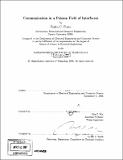| dc.contributor.advisor | Moe Z. Win. | en_US |
| dc.contributor.author | Pinto, Pedro C. (Pedro Correia) | en_US |
| dc.contributor.other | Massachusetts Institute of Technology. Dept. of Electrical Engineering and Computer Science. | en_US |
| dc.date.accessioned | 2007-08-29T20:41:33Z | |
| dc.date.available | 2007-08-29T20:41:33Z | |
| dc.date.copyright | 2006 | en_US |
| dc.date.issued | 2007 | en_US |
| dc.identifier.uri | http://hdl.handle.net/1721.1/38665 | |
| dc.description | Thesis (S.M.)--Massachusetts Institute of Technology, Dept. of Electrical Engineering and Computer Science, February 2007. | en_US |
| dc.description | Includes bibliographical references (p. 81-83). | en_US |
| dc.description.abstract | This thesis presents a mathematical model for communication subject to both interference and noise. We introduce a realistic framework where the interferers are spatially scattered according to a Poisson field, and are operating asynchronously in a wireless environment; subject to path loss, shadowing, and multipath fading. We consider both cases of slow and fast-varying interferer positions. Under this scenario, we determine the statistical distribution of the cumulative interference at the output of a linear receiver, located anywhere in the two-dimensional plane. We characterize the error probability and capacity of the link, when subject to both network interference and thermal noise. We derive the power spectral density (PSD) of the cumulative interference at any location in the plane. We put forth the concept of spectral outage probability (SOP), a new characterization of the cumulative interference generated by communicating nodes in a wireless network. Lastly, we quantify the cumulative interference distribution, error probability, channel capacity, PSD, and SOP as a function of various important system parameters, such as the signal-to-noise ratio (SNR), interference-to-noise ratio (INR), path loss exponent of the channel, and spatial density of the interferers. | en_US |
| dc.description.abstract | (cont.) The proposed model is valid for any linear modulation scheme (e.g., M-ary phase shift keying or M-ary quadrature amplitude modulation), and captures all the essential physical parameters that affect network interference. Nevertheless, it is simple enough to enable a tractable analysis and provide fundamental insights that may be of value to the network designer. Finally, this work generalizes the conventional analysis of linear detection in the presence of additive white Gaussian noise (AWGN) and fast fading, allowing the traditional results to be extended to include the effect of interference. | en_US |
| dc.description.statementofresponsibility | by Pedro C. Pinto. | en_US |
| dc.format.extent | 83 p. | en_US |
| dc.language.iso | eng | en_US |
| dc.publisher | Massachusetts Institute of Technology | en_US |
| dc.rights | M.I.T. theses are protected by copyright. They may be viewed from this source for any purpose, but reproduction or distribution in any format is prohibited without written permission. See provided URL for inquiries about permission. | en_US |
| dc.rights.uri | http://dspace.mit.edu/handle/1721.1/7582 | |
| dc.subject | Electrical Engineering and Computer Science. | en_US |
| dc.title | Communication in a Poisson field of interferers | en_US |
| dc.type | Thesis | en_US |
| dc.description.degree | S.M. | en_US |
| dc.contributor.department | Massachusetts Institute of Technology. Department of Electrical Engineering and Computer Science | |
| dc.identifier.oclc | 163581637 | en_US |
